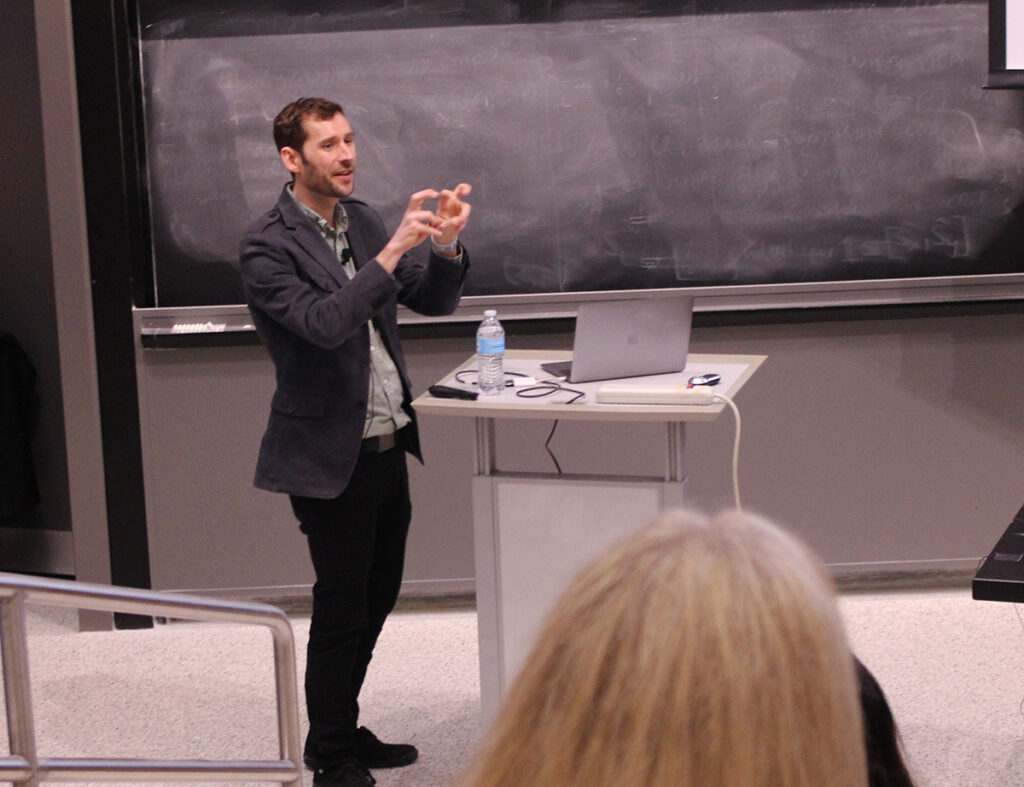DMSE’s new Tenure Talks series examined the careers of two materials scientists who achieved success by overcoming obstacles built into their academic journeys. While trained chemist Robert Macfarlane had to reconcile the ostensibly different disciplines of chemistry and materials science before conducting groundbreaking research in programmable matter, James LeBeau developed new techniques in electron microscopy to solve once uncrackable mysteries about materials’ makeup.
Tenure Talks, which kicked off earlier this fall, give newly tenured professors the chance to discuss the research that helped qualify them for the appointment. But tenure is also much more than that, said DMSE head Jeffrey Grossman.
“It’s about your students. It’s about your mentoring. It’s about the relationships you create. It’s about your creativity. But most importantly, it’s about the human,” said Grossman in his introduction of Macfarlane in 6-120 on Oct. 26. ”We wanted to create this series to bring the human here and have a chance to see the person that got tenure and then celebrate that person.”
“A continuous spectrum”
Macfarlane began his tenure story this way: “It’s the story of somebody who started out their academic life as a dyed-in-the-wool chemist and has now gradually transitioned over to the ‘dark side’ of engineering.”
But as he found in trying to explain his switch, the difference between light and dark—or metaphorically, chemistry and materials science—is not as dramatic as it sounds.
“Material scientists and chemists both work with atoms and molecules and bonding interactions,” Macfarlane said. But each field refers to these things in different ways. For example, materials scientists can gloss over the bonds that make up a material, focusing instead on how microstructural features consisting of arrays of atoms influence physical properties. Chemists, on the other hand, can focus so much on controlling individual bonds that they ignore the bigger picture of the full material.
Using an understanding of concepts from chemistry and materials science— “one big, continuous spectrum,” Marfarlane said—enabled the development of new ways of thinking about developing materials. When assembling his lab at MIT, “I wanted to use my chemistry knowledge to build materials in a more modular kind of way.”
Today the Macfarlane Lab combines a deep knowledge of chemistry—synthetic methods to control material structure at the level of individual bonds, for example—with a materials science understanding of the larger structures that these building blocks ultimately make.
The graduate students and postdoc researchers in the lab (themselves coming from a wide range of scientific backgrounds) use this multidisciplinary approach to develop nanoparticles that can self-assemble into many different types of materials—what Macfarlane calls a “universal, modular approach to materials synthesis.”
I can see clearly now

LeBeau started his talk, on Nov. 2, with a brief description of his primary research tool: the scanning transmission electron microscope, or STEM. The device uses beams of electrons to form images of the arrangement of atoms within a material.
“We really focus on this tool because it opens up the atomic scale of materials to understand how atoms bond together, how we build materials atom by atom to give us the properties that they have,” LeBeau said.
The images can be used to provide detailed descriptions of materials and how they function in a range of applications, from electronics to energy storage to quantum computing.
Though powerful, STEMs are difficult to master, requiring years of specialized training, and even experts like LeBeau could be confounded by readings coming from images of material samples. It began in graduate school, when he puzzled over a mismatch in the image contrast between experiment and that predicted from quantum mechanics, known as the Stobbs factor.
After eliminating the problem for STEM, LeBeau focused on “quantifying the atomic scale,” or using STEM data to precisely measure the underlying crystal structure and chemistry of materials.
LeBeau and his research group used STEM to answer decades-old questions about relaxor ferroelectrics, a not-well-understood family of materials that could be useful in things like sensors and ultrasound imaging devices.
But to democratize electron microscopy, “and make these tools a bit easier to use than they currently are,” LeBeau is using machine learning to develop a self-driving microscope, which could collect data much faster than human scientists and, ultimately, compile a comprehensive profile of a material.
“The field is on a path toward automation that’s really just beginning,” LeBeau said.